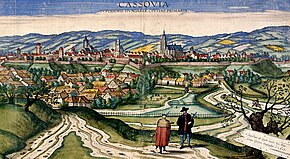
Back المجر العليا Arabic Верхняя Венгрыя Byelorussian Верхняя Вугоршчына BE-X-OLD Horní Uhry Czech Oberungarn German Supra Hungario Esperanto Alta Hungría Spanish Ülem-Ungari Estonian Haute-Hongrie French הונגריה העליונה HE

| History of Hungary |
|---|
 |
|
|
| History of Slovakia |
|---|
 |
|
|
Upper Hungary is the usual English translation of Felvidék (literally: "Upland"), the Hungarian term for the area that was historically the northern part of the Kingdom of Hungary, now mostly present-day Slovakia.[2][3][4][5] The region has also been called Felső-Magyarország (literally: "Upper Hungary"; Slovak: Horné Uhorsko).
During the Habsburg–Ottoman wars, Upper Hungary meant only the northeastern parts of the Hungarian Kingdom. The northwestern regions (present-day western and central Slovakia) belonged to Lower Hungary. Sometime during the 18th or 19th century, Upper Hungary began to imply the whole northern regions of the kingdom. The population of Upper Hungary was mixed and mainly consisted of Slovaks, Hungarians, Germans, Ashkenazi Jews and Ruthenians. The first complex demographic data are from the 18th century, in which Slovaks constituted the majority population in Upper Hungary.[6] Slovaks called this territory "Slovensko" (Slovakia), which term appears in written documents from the 15th century, but it was not precisely defined[7] and the region inhabited by Slovaks held no distinct legal, constitutional, or political status within Upper Hungary.[8]
- ^ Kniha (Matica slovenská) ISSN 1336-5436, 2008: p. 16.
- ^ Gardiner, Duncan (1991). German Towns in Slovakia and Upper Hungary: A Genealogical Gazetteer. ISBN 978-0-929871-02-8. Archived from the original on 2016-04-01. Retrieved 2016-01-05.
- ^ Berger, Tilman (July 2003). "Slovaks in Czechia — Czechs in Slovakia" (PDF). International Journal of the Sociology of Language. 2003 (162): 19–39. doi:10.1515/ijsl.2003.035. ISSN 0165-2516.
- ^ Hirsch, Eric (April 1997). "Voices from the Black Box: Folk Song, Boy Scouts and the Construction of Folk Nationalist Hegemony in Hungary, 1930–1944". Antipode. 29 (2): 197–215. doi:10.1111/1467-8330.00043. ISSN 1467-8330.
- ^ Demarée, G.R.; Ogilvie, A.E.J. (2001). "Bons Baisers d'Islande: Climatic, Environmental, and Human Dimensions Impacts of the Lakagígar Eruption (1783-1784) in Iceland". In Jones, Philip D (ed.). History and Climate: Memories of the Future?. Kluwer Academic Publishers. p. 234. ISBN 0306465892.
- ^ Kocsis, Károly; Kocsisné Hodosi, Eszter (1998). Ethnic Geography of the Hungarian Minorities in the Carpathian Basin. Budapest: Geographical Research Institute Research Centre for Earth Sciences. p. 41. ISBN 9637395849.
- ^ Kováč, Dušan (2011). "Slovakia, the Slovaks and their history". In Teich, Mikuláš; Kováč, Dušan (eds.). Slovakia in history. Cambridge University Press. p. 3. ISBN 978-0521802536.
- ^ Felak, James Ramon (1994). At the Price of the Republic: Hlinka's Slovak People's Party, 1929–1938. University of Pittsburgh Press. p. 3–. ISBN 978-0-8229-3779-1.